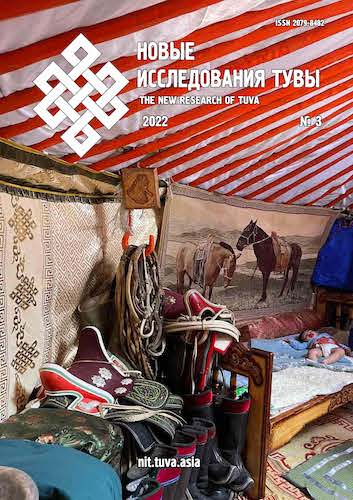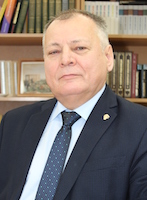The image of a horseman in the sunlight: Heraldic cases of Bashkortostan and Tuva
DOI:
https://doi.org/10.25178/nit.2022.3.15Keywords:
heraldry; national policy; USSR; history of Bashkortostan; Bashkortostan; history of Tuva; Tuva; horseman; coat of armsAbstract
In the 1920s–1930s, a process of constitutional development and creation of symbols of statehood took place in the national republics of the RSFSR and the Tuvan People’s Republic. In 1925, the coat of arms was adopted in the Autonomous Bashkir Soviet Socialist Republic, and it was based on the image of a horseman with a banner in the rays of the sun. The coat of arms was not approved by the federal center.
In the 1930s, the process of “Sovietization” of the autonomies’ coats of arms led to the fact that all of them received the coat of arms of the RSFSR with the name of a particular republic. This phenomenon was associated with the failure of the policy of “korenizatsiya” (“indigenization”) which was pursued by the CPSU(b) in the USSR in 1923–1928. Aimed at creating a Soviet national elite, it led to the emergence of nationalism in the regions. The throwback to conservative positions forced the party leadership to move towards the unification of heraldic practice. In the Tuvan People’s Republic, the “leftist experiment” led to crisis phenomena which resulted in the retreat from the radical policy. The change of course led to the replacement of the “Soviet” version of the coat of arms with the “national” one that had the image of a horseman in the sun. In the coat of arms of 1935, the ancient Turkic cultural tradition was integrated with the Buddhist one through the sign of the mandala.
In 1992–1993, the republics of Tuva and Bashkortostan — the subjects of the Russian Federation — adopted new coats of arms which are based on the image of a horseman in the rays of the sun. Tuva used the basis of the coat of arms of 1935, and Bashkortostan placed the monument to the national hero Salavat Yulaev in the sunshine on the coat of arms. The image of a horseman in the sun goes back to antiquity. It personifies the archetype of the nomad and harmony with nature. In the Turkic and Mongolian epic literature, the horse, in some cases, serves the function of the sun. The phenomenon of the heraldic tradition of Bashkortostan and Tuva lies in the fact that the ancient image as the basis of national identity in symbolic practice turned out to be more significant than images associated with religious or political identity.
References
Aznabaev, B. A. (2016) Bashkirskoe obshchestvo v XVII — pervoi treti XVIII v. [Bashkir society in the 17th — first third of the 18th c.]. Ufa, Editorial and Publishing Center at Bashkir State University. 370 p. (In Russ.).
Bezrukov, A. V. (2017) Stanovlenie i razvitie gosudarstvennogo regional'nogo gerba (na primere sub"ektov, vkhodiashchikh v sostav RSFSR) [The formation and development of state regional emblem (the example of the regions of the RSFSR)]. Nauka. Obshchestvo. Gosudarstvo, vol. 5, no. 2 (18), pp. 5–9. (In Russ.).
Bicheldei, K. A. and Mongush, B. B. (2019) Gosudarstvennye simvoly Tuvy. Gerb, flag i gimn. Denezhnye i pochtovye znaki [State symbols of Tuva. Coat of arms, flag and anthem. Money and postage]. Kyzyl, Tuvan Book Publishing House. 112 p. (In Russ.).
Borisenok, E. (2006) Fenomen sovetskoi ukrainizatsii. 1920–1930-e gody [The phenomenon of Soviet Ukrainization. 1920s–1930s]. Moscow, Evropa. 256 p. (In Russ.).
Voronin, R. M. (2022) Pochtovye marki perioda Tuvinskoi Narodnoi Respubliki kak otrazhenie evoliutsii obshchestvennogo soznaniia tuvintsev [Postage stamps of the Tuvan People’s Republic as a reflection of evolving public consciousness of the Tuvan people]. New Research of Tuva, no. 2, pp. 177–187. (In Russ.). DOI: https://doi.org/10.25178/nit.2022.2.12
Geral'dika Rossii: polnaia illiustrirovannaia entsiklopediia [Heraldry of Russia: A complete illustrated encyclopedia] (2008) / comp. by A. G. Merinov. Moscow, Avanta+. 512 p. (In Russ.).
Giliazov, I. A. (2005) Legion «Idel'–Ural». Predstaviteli narodov Povolzh'ia i Priural'ia pod znamenami «tret'ego reikha» [Legion “Idel–Ural”. Representatives of the peoples of the Volga region and the Cisurals under the banner of the “Third Reich”]. Kazan, Tatar Book Publishing House. 383 p. (In Russ.).
Gosudarstvennye i munitsipal'nye simvoly Respubliki Tatarstan [State and municipal symbols of the Republic of Tatarstan] (2017) / compiled by L. M. Ainutdinova, I. R. Valiullin, B. L. Khamidullin and R. V. Shaidullin. Kazan, Tatar Book Publishing House. 248 p. (In Russ.).
Drobiazko, S. and Karashchuk, A. (2000) Vostochnye legiony i kazach'i chasti v vermakhte [Eastern legions and Cossack units in the Wehrmacht]. Moscow, AST. 48 p. (In Russ.).
Drozdov, K. S. (2016) Politika ukrainizatsii v Tsentral'nom Chernozem'e, 1923–1933 [The policy of Ukrainization in the Central Chernozem region, 1923–1933]. Moscow, Institute of Russian History of the RAS. 487 p. (In Russ.).
Ilimbetova, A. F. and Ilimbetov, F. F. (2012) Kul't zhivotnykh v miforitual'noi traditsii bashkir [The cult of animals in the Bashkir mythological tradition]. 2nd ed. Ufa, Academy of Sciences of the Republic of Bashkortostan, Gilem. 704 p. (In Russ.).
Kornikov, A. A. (2016) Geral'dicheskoe mnogoobrazie Rossii. Gerby sub"ektov Rossiiskoi Federatsii: sovremennoe sostoianie, problemy i poiski [The heraldic diversity of Russia. Coats of arms of the subjects of the Russian Federation: Current state, problems and research]. Vestnik Ivanovskogo gosudarstvennogo universiteta. Seriia: Gumanitarnye nauki, no. 3 (9), pp. 51–58. (In Russ.).
Martin, T. (2011) Imperiia «polozhitel'noi deiatel'nosti». Natsii i natsionalizm v SSSR. 1923–1939 [The affirmative action empire: Nations and nationalism in the Soviet Union, 1923–1939] / transl. from Engl. by O. R. Shchelokova. Moscow, Rossiiskaia politicheskaia entsiklopediia (ROSSPEN) ; Foundation “Boris Yeltsin Presidential Center”. 855 p. (In Russ.).
Mongush, B. B. (2011) Stanovlenie gosudarstvennoi simvoliki Tuvinskoi narodnoi respubliki [Formation of the state symbols of the People’s Republic of Tuva]. New Research of Tuva, no. 4, pp. 79–82. (In Russ.).
Mongush, B. B. (2016) Gerb Tuvinskoi Narodnoi Respubliki 1935–1939 gg.: otrazhenie v simvolike traditsionnykh kosmologicheskikh predstavlenii tuvintsev [Elements of traditional Tuvan cosmology in the state emblem of the People’s Republic of Tuva, 1935–1939]. New Research of Tuva, no. 3, pp. 54–64. (In Russ.).
Mochenov, K. F. and Korzhik, Yu. V. (2005) Gerby sovremennoi Rossii [Coats of arms of modern Russia] : A guide. Moscow, Gerby i flagi. 296 p. (In Russ.).
Saprykov, V. N. (2004) Gosudarstvennaia simvolika regionov Rossii [State symbols of Russian regions]. Moscow, Parad. 96 p. (In Russ.).
Sat, S. Ch. and Irgit, A. Sh. (2013) Gosudarstvennye simvoly Tuvy na sovremennom etape [State symbols of Tuva at the present stage]. Vestnik Irkutskogo gosudarstvennogo tekhnicheskogo universiteta, no. 12 (83), pp. 414–417. (In Russ.).
Smetannikov, I. S. (2003) Gerby i flagi sub"ektov Rossiiskoi Federatsii [Coats of arms and flags of the subjects of the Russian Federation]. Moscow, Kompaniia Ritm Esteit. 112 p. (In Russ.).
Soboleva, N. A. (2018) Identichnost' Rossiiskogo gosudarstva iazykom znakov i simvolov: emblematiki, geral'diki, sfragistiki, veksillologii [The identity of the Russian state in the language of signs and symbols: Emblematics, heraldry, sphragistics, vexillology]. 2nd ed. Moscow, LRC Publishing House. 656 p. (In Russ.).
Tkachenko, V. G. (2015) Gosudarstvennaia i munitsipal'naia simvolika Chuvashii v istoricheskom diskurse [State and municipal symbols of Chuvashia in historical discourse]. Cheboksary, Novoe vremia. 184 p. (In Russ.).
Frolova, I. V. and Urazova, A. I. (2020) Politika pamiati i istoricheskaia nauka: nauchnye itogi goda, posviashchennogo stoletiiu Respubliki Bashkortostan [Memory policy and historical science: Scientific results of the year dedicated to the centenary of the Republic of Bashkortostan]. Modern History of Russia, vol. 10, no. 4, pp. 1019–1031. (In Russ.). DOI: https://doi.org/10.21638/11701/spbu24.2020.413
TsK RKP(b) — VKP(b) i natsional'nyi vopros [The Central Committee of the RCP(b) — the CPSU(b) and the national question] (2005) : in 2 books / comp. by L. S. Gatagova, L. P. Kosheleva and L. A. Rogovaia. Moscow, Rossiiskaia politicheskaia entsiklopediia (ROSSPEN). Book 1: 1918–1933. 784 p. (In Russ.).
Hroch, M. (1985) Social preconditions of national revival in Europe: A comparative analysis of the social composition of patriotic groups among the smaller European nations. Cambridge, UK. Cambridge University Press. xiii, 220 p.
Published
How to Cite
For citation:
Rakhimov R. N., Aznabaev B. A. and Frolova I. V. Obraz vsadnika v luchakh solntsa: geral’dicheskie keisy Bashkortostana i Tuvy [The image of a horseman in the sunlight: Heraldic cases of Bashkortostan and Tuva]. New Research of Tuva, 2022, no. 3, pp. 226-240. (In Russ.). DOI: https://www.doi.org/10.25178/nit.2022.3.15
Issue
Section

This work is licensed under a Creative Commons Attribution-NonCommercial 4.0 International License.

Author(s) license holder(s) grant rights for their work to the journal (grantee of a license) under the simple non-exclusive open license in accordance with Art. 1286.1 «Open license for a research work, work of literature or fine arts», Civil Code of the Russian Federation.
New Research of Tuva publishes articles under the Creative Commons Attribution-NonCommercial license (CC BY-NC).
Since it is an open license, author(s) reserve the right to upload the article to their institutional repository, submit it to another journal (if it allows republications), or republish it on their own website (in full, or in part).
However, several conditions apply here:
a) The republished version must always contain the name(s) and affiliation(s) of the author(s), the original title and the hyperlink to the original version on the New Research of Tuva website;
b) It must be in open access, free of charge, and no category of readers must be in any way whatsoever advantaged over general readership.
c) should the contribution be submitted elsewhere by its author(s) without substantial modification (30% or more of original text unchanged), the body of the article should contain a disclaimer that the original version was published in New Research of Tuva (with a link to the respective page)
The CC-BY-NC is a non-revocable license which applies worldwide and lasts for the duration of the work’s copyright.











